Communication and Diversity: Aboriginal Healthcare Experience Analysis
VerifiedAdded on 2022/12/18
|6
|1778
|38
Essay
AI Summary
This essay delves into the critical aspects of communication and diversity within Aboriginal healthcare, emphasizing the significance of cultural safety and respectful practices. It explores the experiences of Aboriginal patients within the healthcare system, highlighting the consequences of bias and the impact of communication skills on the quality of care. The essay underscores the need for nurses and healthcare providers to critically examine their own biases and behaviors to ensure non-judgmental, empathic, and compassionate care. It discusses strategies to address health inequities and promote trust, focusing on the importance of understanding cultural needs and providing unbiased services. The content covers topics such as cultural safety, patient experiences, and the impact of bias from nurses and healthcare providers. The essay also references the Nursing and Midwifery Board of Australia's guidelines on culturally safe care and advocates for improved communication and the removal of linguistic and cultural discrepancies to regain the trust of Aboriginal communities.
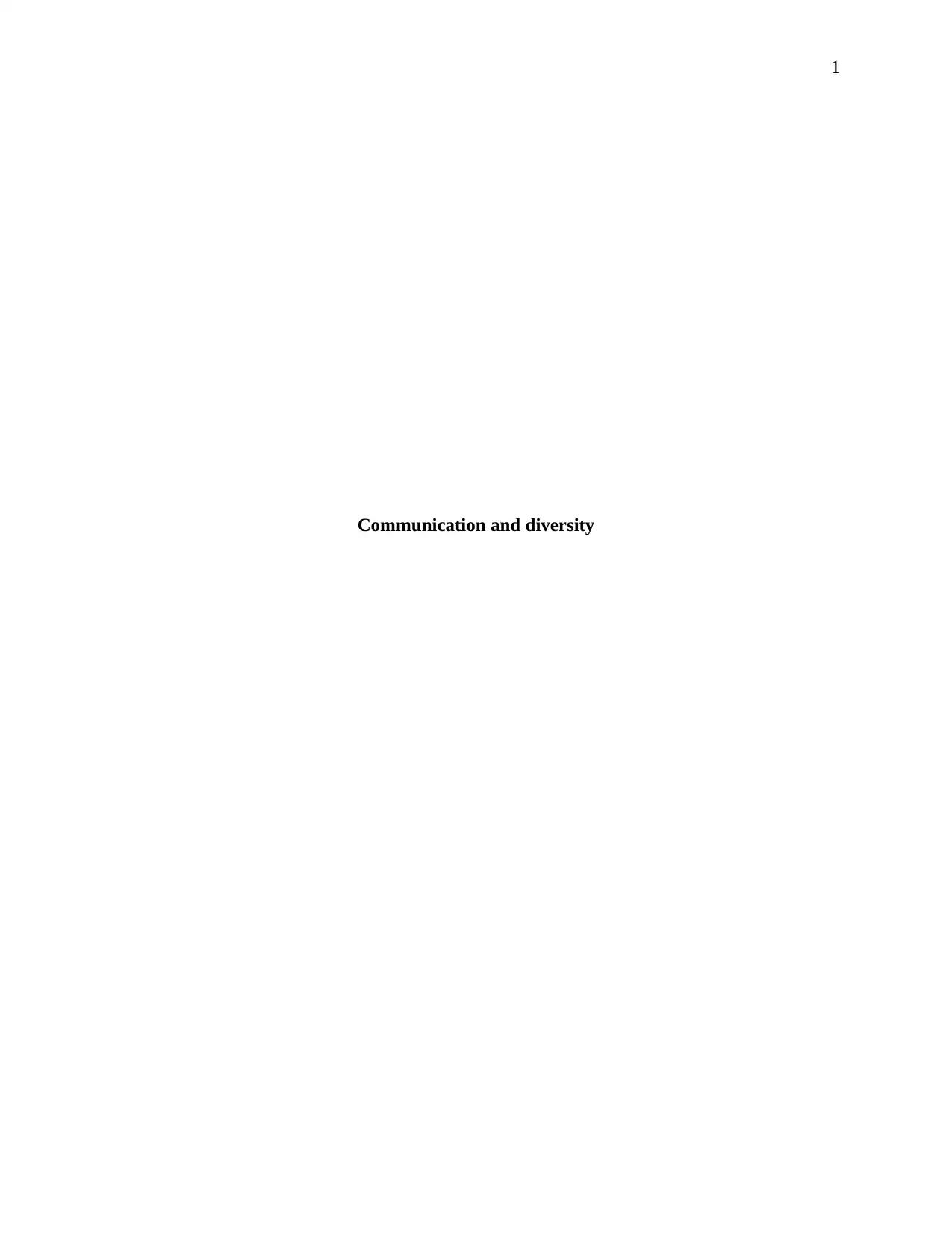
1
Communication and diversity
Communication and diversity
Paraphrase This Document
Need a fresh take? Get an instant paraphrase of this document with our AI Paraphraser
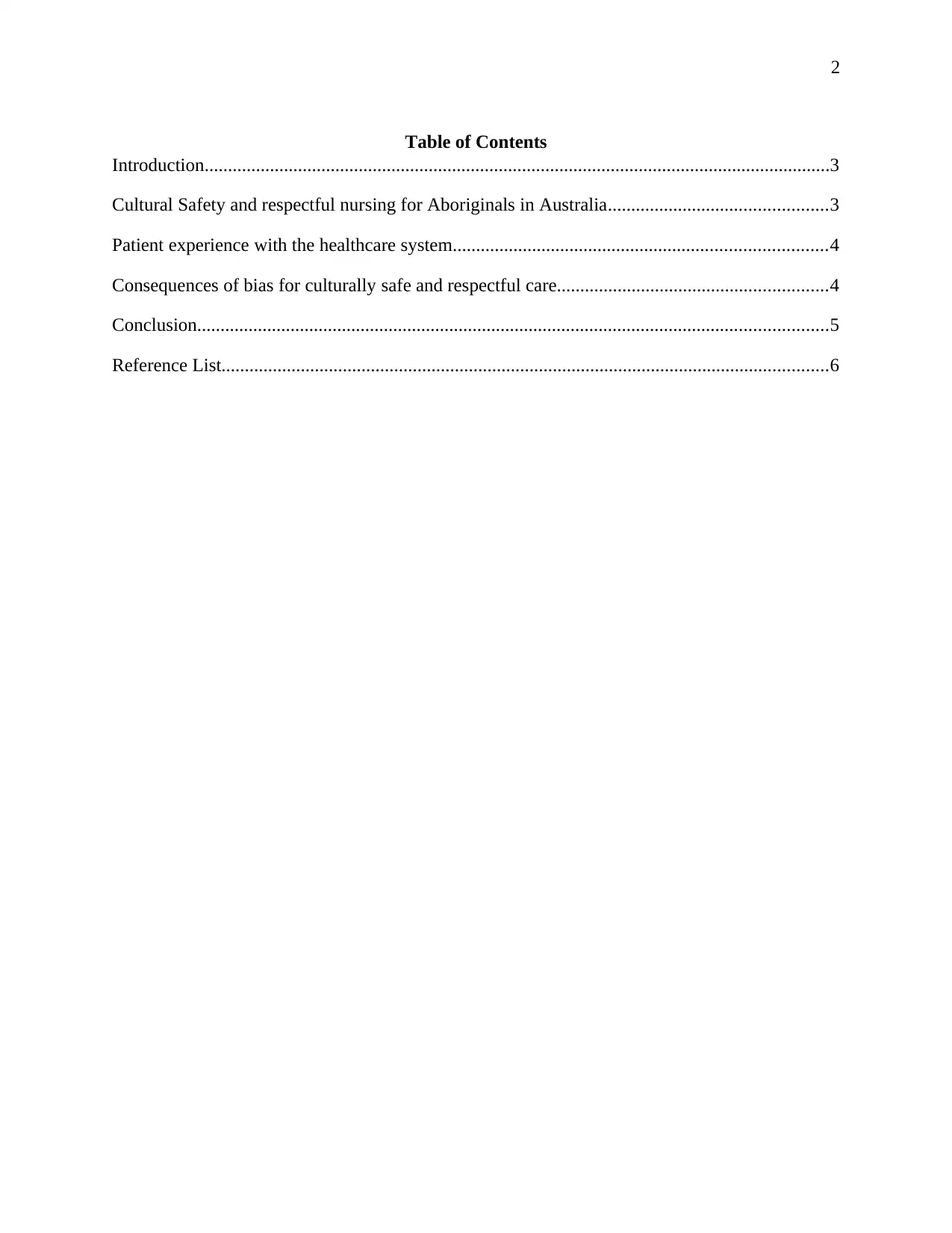
2
Table of Contents
Introduction......................................................................................................................................3
Cultural Safety and respectful nursing for Aboriginals in Australia...............................................3
Patient experience with the healthcare system................................................................................4
Consequences of bias for culturally safe and respectful care..........................................................4
Conclusion.......................................................................................................................................5
Reference List..................................................................................................................................6
Table of Contents
Introduction......................................................................................................................................3
Cultural Safety and respectful nursing for Aboriginals in Australia...............................................3
Patient experience with the healthcare system................................................................................4
Consequences of bias for culturally safe and respectful care..........................................................4
Conclusion.......................................................................................................................................5
Reference List..................................................................................................................................6
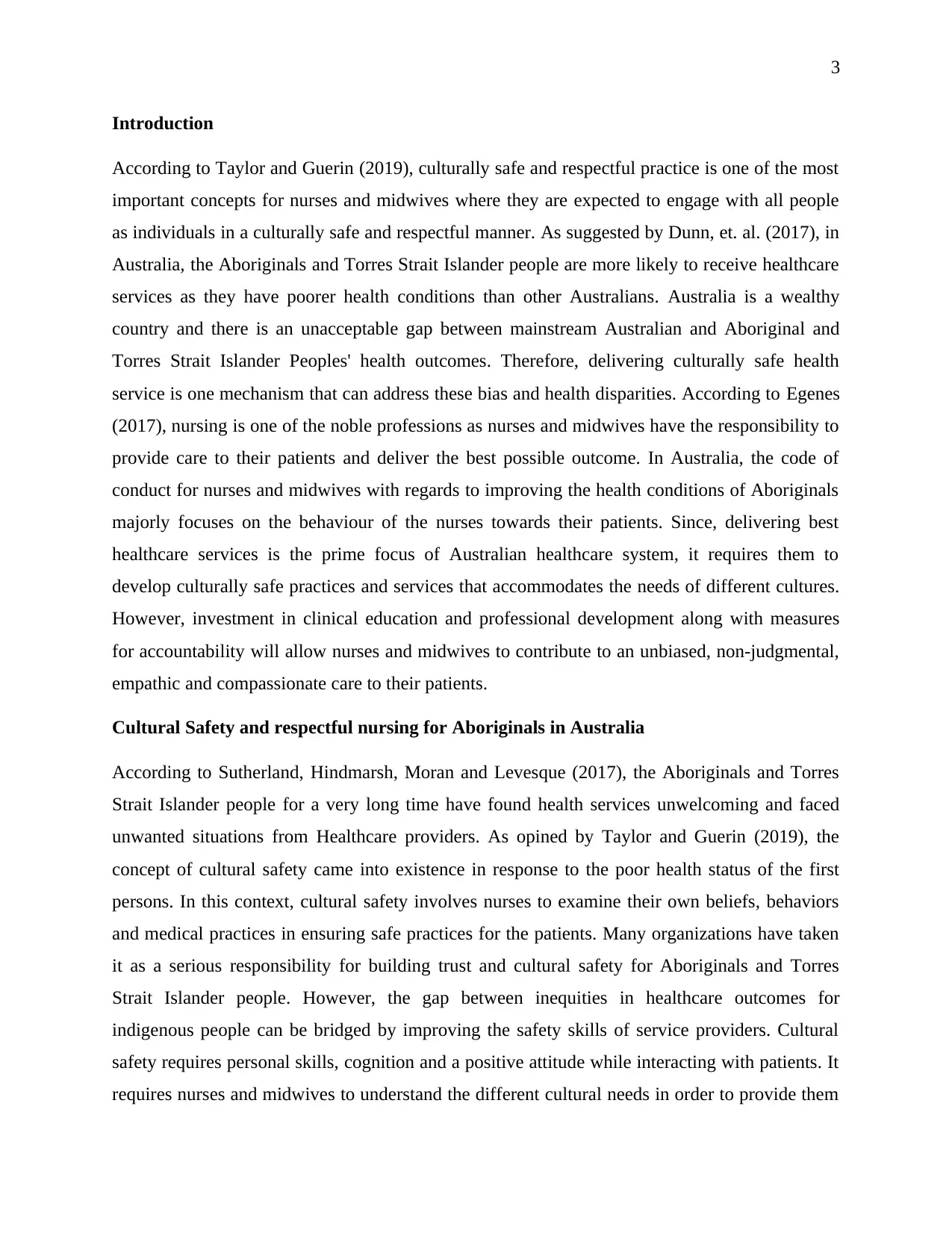
3
Introduction
According to Taylor and Guerin (2019), culturally safe and respectful practice is one of the most
important concepts for nurses and midwives where they are expected to engage with all people
as individuals in a culturally safe and respectful manner. As suggested by Dunn, et. al. (2017), in
Australia, the Aboriginals and Torres Strait Islander people are more likely to receive healthcare
services as they have poorer health conditions than other Australians. Australia is a wealthy
country and there is an unacceptable gap between mainstream Australian and Aboriginal and
Torres Strait Islander Peoples' health outcomes. Therefore, delivering culturally safe health
service is one mechanism that can address these bias and health disparities. According to Egenes
(2017), nursing is one of the noble professions as nurses and midwives have the responsibility to
provide care to their patients and deliver the best possible outcome. In Australia, the code of
conduct for nurses and midwives with regards to improving the health conditions of Aboriginals
majorly focuses on the behaviour of the nurses towards their patients. Since, delivering best
healthcare services is the prime focus of Australian healthcare system, it requires them to
develop culturally safe practices and services that accommodates the needs of different cultures.
However, investment in clinical education and professional development along with measures
for accountability will allow nurses and midwives to contribute to an unbiased, non-judgmental,
empathic and compassionate care to their patients.
Cultural Safety and respectful nursing for Aboriginals in Australia
According to Sutherland, Hindmarsh, Moran and Levesque (2017), the Aboriginals and Torres
Strait Islander people for a very long time have found health services unwelcoming and faced
unwanted situations from Healthcare providers. As opined by Taylor and Guerin (2019), the
concept of cultural safety came into existence in response to the poor health status of the first
persons. In this context, cultural safety involves nurses to examine their own beliefs, behaviors
and medical practices in ensuring safe practices for the patients. Many organizations have taken
it as a serious responsibility for building trust and cultural safety for Aboriginals and Torres
Strait Islander people. However, the gap between inequities in healthcare outcomes for
indigenous people can be bridged by improving the safety skills of service providers. Cultural
safety requires personal skills, cognition and a positive attitude while interacting with patients. It
requires nurses and midwives to understand the different cultural needs in order to provide them
Introduction
According to Taylor and Guerin (2019), culturally safe and respectful practice is one of the most
important concepts for nurses and midwives where they are expected to engage with all people
as individuals in a culturally safe and respectful manner. As suggested by Dunn, et. al. (2017), in
Australia, the Aboriginals and Torres Strait Islander people are more likely to receive healthcare
services as they have poorer health conditions than other Australians. Australia is a wealthy
country and there is an unacceptable gap between mainstream Australian and Aboriginal and
Torres Strait Islander Peoples' health outcomes. Therefore, delivering culturally safe health
service is one mechanism that can address these bias and health disparities. According to Egenes
(2017), nursing is one of the noble professions as nurses and midwives have the responsibility to
provide care to their patients and deliver the best possible outcome. In Australia, the code of
conduct for nurses and midwives with regards to improving the health conditions of Aboriginals
majorly focuses on the behaviour of the nurses towards their patients. Since, delivering best
healthcare services is the prime focus of Australian healthcare system, it requires them to
develop culturally safe practices and services that accommodates the needs of different cultures.
However, investment in clinical education and professional development along with measures
for accountability will allow nurses and midwives to contribute to an unbiased, non-judgmental,
empathic and compassionate care to their patients.
Cultural Safety and respectful nursing for Aboriginals in Australia
According to Sutherland, Hindmarsh, Moran and Levesque (2017), the Aboriginals and Torres
Strait Islander people for a very long time have found health services unwelcoming and faced
unwanted situations from Healthcare providers. As opined by Taylor and Guerin (2019), the
concept of cultural safety came into existence in response to the poor health status of the first
persons. In this context, cultural safety involves nurses to examine their own beliefs, behaviors
and medical practices in ensuring safe practices for the patients. Many organizations have taken
it as a serious responsibility for building trust and cultural safety for Aboriginals and Torres
Strait Islander people. However, the gap between inequities in healthcare outcomes for
indigenous people can be bridged by improving the safety skills of service providers. Cultural
safety requires personal skills, cognition and a positive attitude while interacting with patients. It
requires nurses and midwives to understand the different cultural needs in order to provide them
⊘ This is a preview!⊘
Do you want full access?
Subscribe today to unlock all pages.

Trusted by 1+ million students worldwide
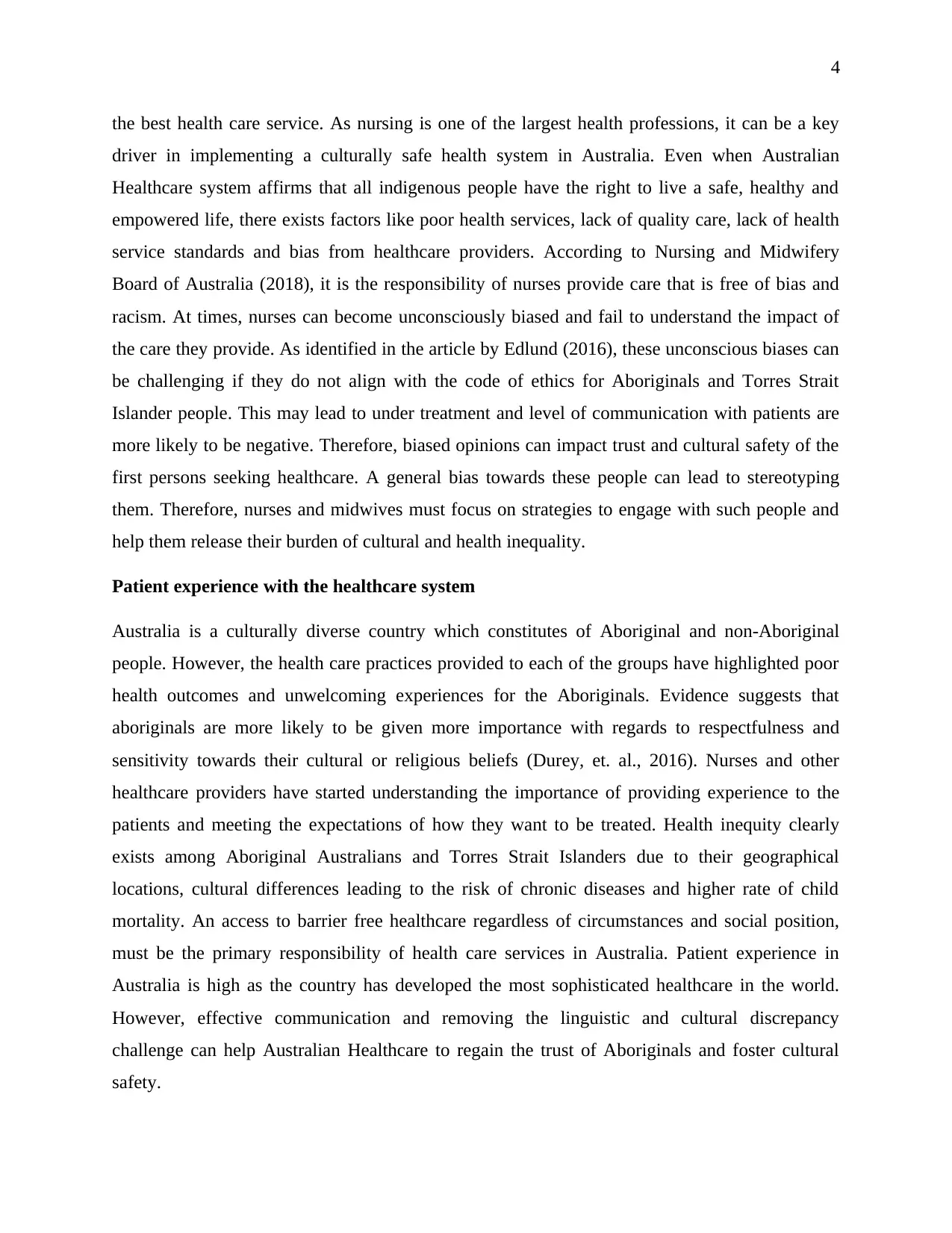
4
the best health care service. As nursing is one of the largest health professions, it can be a key
driver in implementing a culturally safe health system in Australia. Even when Australian
Healthcare system affirms that all indigenous people have the right to live a safe, healthy and
empowered life, there exists factors like poor health services, lack of quality care, lack of health
service standards and bias from healthcare providers. According to Nursing and Midwifery
Board of Australia (2018), it is the responsibility of nurses provide care that is free of bias and
racism. At times, nurses can become unconsciously biased and fail to understand the impact of
the care they provide. As identified in the article by Edlund (2016), these unconscious biases can
be challenging if they do not align with the code of ethics for Aboriginals and Torres Strait
Islander people. This may lead to under treatment and level of communication with patients are
more likely to be negative. Therefore, biased opinions can impact trust and cultural safety of the
first persons seeking healthcare. A general bias towards these people can lead to stereotyping
them. Therefore, nurses and midwives must focus on strategies to engage with such people and
help them release their burden of cultural and health inequality.
Patient experience with the healthcare system
Australia is a culturally diverse country which constitutes of Aboriginal and non-Aboriginal
people. However, the health care practices provided to each of the groups have highlighted poor
health outcomes and unwelcoming experiences for the Aboriginals. Evidence suggests that
aboriginals are more likely to be given more importance with regards to respectfulness and
sensitivity towards their cultural or religious beliefs (Durey, et. al., 2016). Nurses and other
healthcare providers have started understanding the importance of providing experience to the
patients and meeting the expectations of how they want to be treated. Health inequity clearly
exists among Aboriginal Australians and Torres Strait Islanders due to their geographical
locations, cultural differences leading to the risk of chronic diseases and higher rate of child
mortality. An access to barrier free healthcare regardless of circumstances and social position,
must be the primary responsibility of health care services in Australia. Patient experience in
Australia is high as the country has developed the most sophisticated healthcare in the world.
However, effective communication and removing the linguistic and cultural discrepancy
challenge can help Australian Healthcare to regain the trust of Aboriginals and foster cultural
safety.
the best health care service. As nursing is one of the largest health professions, it can be a key
driver in implementing a culturally safe health system in Australia. Even when Australian
Healthcare system affirms that all indigenous people have the right to live a safe, healthy and
empowered life, there exists factors like poor health services, lack of quality care, lack of health
service standards and bias from healthcare providers. According to Nursing and Midwifery
Board of Australia (2018), it is the responsibility of nurses provide care that is free of bias and
racism. At times, nurses can become unconsciously biased and fail to understand the impact of
the care they provide. As identified in the article by Edlund (2016), these unconscious biases can
be challenging if they do not align with the code of ethics for Aboriginals and Torres Strait
Islander people. This may lead to under treatment and level of communication with patients are
more likely to be negative. Therefore, biased opinions can impact trust and cultural safety of the
first persons seeking healthcare. A general bias towards these people can lead to stereotyping
them. Therefore, nurses and midwives must focus on strategies to engage with such people and
help them release their burden of cultural and health inequality.
Patient experience with the healthcare system
Australia is a culturally diverse country which constitutes of Aboriginal and non-Aboriginal
people. However, the health care practices provided to each of the groups have highlighted poor
health outcomes and unwelcoming experiences for the Aboriginals. Evidence suggests that
aboriginals are more likely to be given more importance with regards to respectfulness and
sensitivity towards their cultural or religious beliefs (Durey, et. al., 2016). Nurses and other
healthcare providers have started understanding the importance of providing experience to the
patients and meeting the expectations of how they want to be treated. Health inequity clearly
exists among Aboriginal Australians and Torres Strait Islanders due to their geographical
locations, cultural differences leading to the risk of chronic diseases and higher rate of child
mortality. An access to barrier free healthcare regardless of circumstances and social position,
must be the primary responsibility of health care services in Australia. Patient experience in
Australia is high as the country has developed the most sophisticated healthcare in the world.
However, effective communication and removing the linguistic and cultural discrepancy
challenge can help Australian Healthcare to regain the trust of Aboriginals and foster cultural
safety.
Paraphrase This Document
Need a fresh take? Get an instant paraphrase of this document with our AI Paraphraser
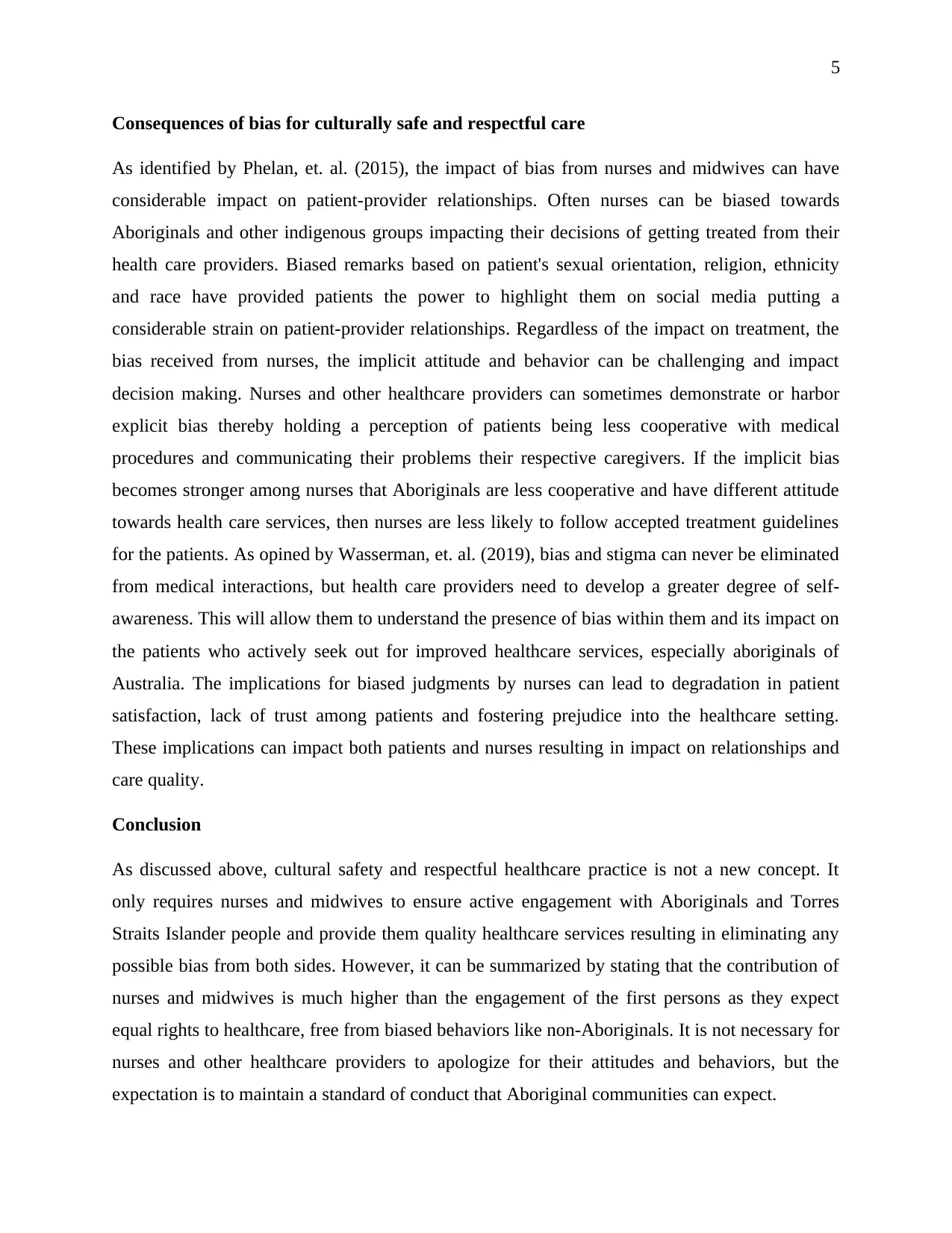
5
Consequences of bias for culturally safe and respectful care
As identified by Phelan, et. al. (2015), the impact of bias from nurses and midwives can have
considerable impact on patient-provider relationships. Often nurses can be biased towards
Aboriginals and other indigenous groups impacting their decisions of getting treated from their
health care providers. Biased remarks based on patient's sexual orientation, religion, ethnicity
and race have provided patients the power to highlight them on social media putting a
considerable strain on patient-provider relationships. Regardless of the impact on treatment, the
bias received from nurses, the implicit attitude and behavior can be challenging and impact
decision making. Nurses and other healthcare providers can sometimes demonstrate or harbor
explicit bias thereby holding a perception of patients being less cooperative with medical
procedures and communicating their problems their respective caregivers. If the implicit bias
becomes stronger among nurses that Aboriginals are less cooperative and have different attitude
towards health care services, then nurses are less likely to follow accepted treatment guidelines
for the patients. As opined by Wasserman, et. al. (2019), bias and stigma can never be eliminated
from medical interactions, but health care providers need to develop a greater degree of self-
awareness. This will allow them to understand the presence of bias within them and its impact on
the patients who actively seek out for improved healthcare services, especially aboriginals of
Australia. The implications for biased judgments by nurses can lead to degradation in patient
satisfaction, lack of trust among patients and fostering prejudice into the healthcare setting.
These implications can impact both patients and nurses resulting in impact on relationships and
care quality.
Conclusion
As discussed above, cultural safety and respectful healthcare practice is not a new concept. It
only requires nurses and midwives to ensure active engagement with Aboriginals and Torres
Straits Islander people and provide them quality healthcare services resulting in eliminating any
possible bias from both sides. However, it can be summarized by stating that the contribution of
nurses and midwives is much higher than the engagement of the first persons as they expect
equal rights to healthcare, free from biased behaviors like non-Aboriginals. It is not necessary for
nurses and other healthcare providers to apologize for their attitudes and behaviors, but the
expectation is to maintain a standard of conduct that Aboriginal communities can expect.
Consequences of bias for culturally safe and respectful care
As identified by Phelan, et. al. (2015), the impact of bias from nurses and midwives can have
considerable impact on patient-provider relationships. Often nurses can be biased towards
Aboriginals and other indigenous groups impacting their decisions of getting treated from their
health care providers. Biased remarks based on patient's sexual orientation, religion, ethnicity
and race have provided patients the power to highlight them on social media putting a
considerable strain on patient-provider relationships. Regardless of the impact on treatment, the
bias received from nurses, the implicit attitude and behavior can be challenging and impact
decision making. Nurses and other healthcare providers can sometimes demonstrate or harbor
explicit bias thereby holding a perception of patients being less cooperative with medical
procedures and communicating their problems their respective caregivers. If the implicit bias
becomes stronger among nurses that Aboriginals are less cooperative and have different attitude
towards health care services, then nurses are less likely to follow accepted treatment guidelines
for the patients. As opined by Wasserman, et. al. (2019), bias and stigma can never be eliminated
from medical interactions, but health care providers need to develop a greater degree of self-
awareness. This will allow them to understand the presence of bias within them and its impact on
the patients who actively seek out for improved healthcare services, especially aboriginals of
Australia. The implications for biased judgments by nurses can lead to degradation in patient
satisfaction, lack of trust among patients and fostering prejudice into the healthcare setting.
These implications can impact both patients and nurses resulting in impact on relationships and
care quality.
Conclusion
As discussed above, cultural safety and respectful healthcare practice is not a new concept. It
only requires nurses and midwives to ensure active engagement with Aboriginals and Torres
Straits Islander people and provide them quality healthcare services resulting in eliminating any
possible bias from both sides. However, it can be summarized by stating that the contribution of
nurses and midwives is much higher than the engagement of the first persons as they expect
equal rights to healthcare, free from biased behaviors like non-Aboriginals. It is not necessary for
nurses and other healthcare providers to apologize for their attitudes and behaviors, but the
expectation is to maintain a standard of conduct that Aboriginal communities can expect.
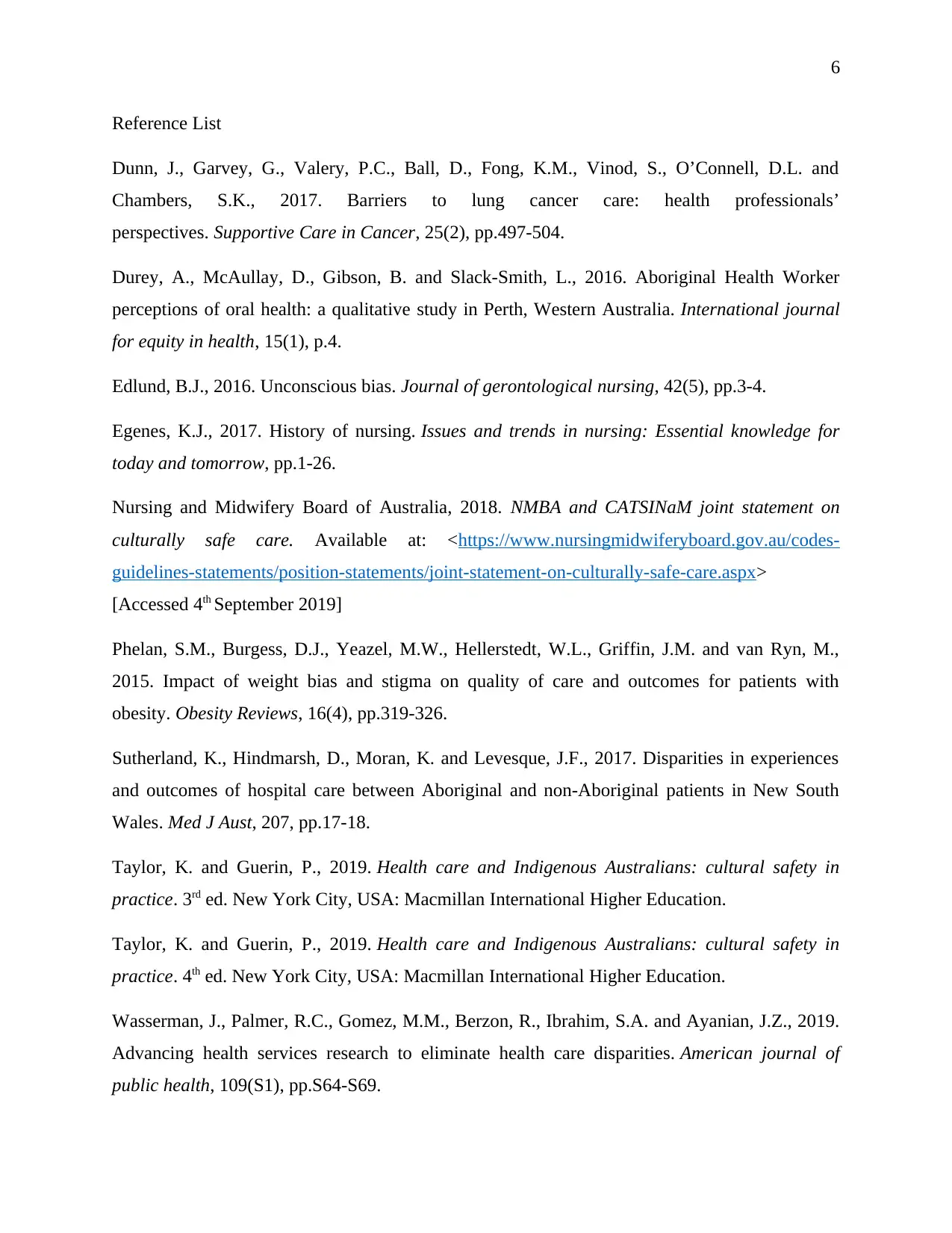
6
Reference List
Dunn, J., Garvey, G., Valery, P.C., Ball, D., Fong, K.M., Vinod, S., O’Connell, D.L. and
Chambers, S.K., 2017. Barriers to lung cancer care: health professionals’
perspectives. Supportive Care in Cancer, 25(2), pp.497-504.
Durey, A., McAullay, D., Gibson, B. and Slack-Smith, L., 2016. Aboriginal Health Worker
perceptions of oral health: a qualitative study in Perth, Western Australia. International journal
for equity in health, 15(1), p.4.
Edlund, B.J., 2016. Unconscious bias. Journal of gerontological nursing, 42(5), pp.3-4.
Egenes, K.J., 2017. History of nursing. Issues and trends in nursing: Essential knowledge for
today and tomorrow, pp.1-26.
Nursing and Midwifery Board of Australia, 2018. NMBA and CATSINaM joint statement on
culturally safe care. Available at: <https://www.nursingmidwiferyboard.gov.au/codes-
guidelines-statements/position-statements/joint-statement-on-culturally-safe-care.aspx>
[Accessed 4th September 2019]
Phelan, S.M., Burgess, D.J., Yeazel, M.W., Hellerstedt, W.L., Griffin, J.M. and van Ryn, M.,
2015. Impact of weight bias and stigma on quality of care and outcomes for patients with
obesity. Obesity Reviews, 16(4), pp.319-326.
Sutherland, K., Hindmarsh, D., Moran, K. and Levesque, J.F., 2017. Disparities in experiences
and outcomes of hospital care between Aboriginal and non-Aboriginal patients in New South
Wales. Med J Aust, 207, pp.17-18.
Taylor, K. and Guerin, P., 2019. Health care and Indigenous Australians: cultural safety in
practice. 3rd ed. New York City, USA: Macmillan International Higher Education.
Taylor, K. and Guerin, P., 2019. Health care and Indigenous Australians: cultural safety in
practice. 4th ed. New York City, USA: Macmillan International Higher Education.
Wasserman, J., Palmer, R.C., Gomez, M.M., Berzon, R., Ibrahim, S.A. and Ayanian, J.Z., 2019.
Advancing health services research to eliminate health care disparities. American journal of
public health, 109(S1), pp.S64-S69.
Reference List
Dunn, J., Garvey, G., Valery, P.C., Ball, D., Fong, K.M., Vinod, S., O’Connell, D.L. and
Chambers, S.K., 2017. Barriers to lung cancer care: health professionals’
perspectives. Supportive Care in Cancer, 25(2), pp.497-504.
Durey, A., McAullay, D., Gibson, B. and Slack-Smith, L., 2016. Aboriginal Health Worker
perceptions of oral health: a qualitative study in Perth, Western Australia. International journal
for equity in health, 15(1), p.4.
Edlund, B.J., 2016. Unconscious bias. Journal of gerontological nursing, 42(5), pp.3-4.
Egenes, K.J., 2017. History of nursing. Issues and trends in nursing: Essential knowledge for
today and tomorrow, pp.1-26.
Nursing and Midwifery Board of Australia, 2018. NMBA and CATSINaM joint statement on
culturally safe care. Available at: <https://www.nursingmidwiferyboard.gov.au/codes-
guidelines-statements/position-statements/joint-statement-on-culturally-safe-care.aspx>
[Accessed 4th September 2019]
Phelan, S.M., Burgess, D.J., Yeazel, M.W., Hellerstedt, W.L., Griffin, J.M. and van Ryn, M.,
2015. Impact of weight bias and stigma on quality of care and outcomes for patients with
obesity. Obesity Reviews, 16(4), pp.319-326.
Sutherland, K., Hindmarsh, D., Moran, K. and Levesque, J.F., 2017. Disparities in experiences
and outcomes of hospital care between Aboriginal and non-Aboriginal patients in New South
Wales. Med J Aust, 207, pp.17-18.
Taylor, K. and Guerin, P., 2019. Health care and Indigenous Australians: cultural safety in
practice. 3rd ed. New York City, USA: Macmillan International Higher Education.
Taylor, K. and Guerin, P., 2019. Health care and Indigenous Australians: cultural safety in
practice. 4th ed. New York City, USA: Macmillan International Higher Education.
Wasserman, J., Palmer, R.C., Gomez, M.M., Berzon, R., Ibrahim, S.A. and Ayanian, J.Z., 2019.
Advancing health services research to eliminate health care disparities. American journal of
public health, 109(S1), pp.S64-S69.
⊘ This is a preview!⊘
Do you want full access?
Subscribe today to unlock all pages.

Trusted by 1+ million students worldwide
1 out of 6
Related Documents
Your All-in-One AI-Powered Toolkit for Academic Success.
+13062052269
info@desklib.com
Available 24*7 on WhatsApp / Email
![[object Object]](/_next/static/media/star-bottom.7253800d.svg)
Unlock your academic potential
Copyright © 2020–2025 A2Z Services. All Rights Reserved. Developed and managed by ZUCOL.





